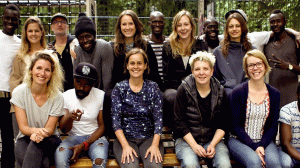A proper ecosystem is indispensable for every entrepreneur - be it a classic "unicorn" or a sustainable zebra. Anika Horn from Social Venturers has written a fantastic article on how to build an entrepreneurial ecosystem and what to consider. In this article, she shares seven guiding principles to help you navigate - and cultivate - your ecosystem.
For entrepreneurs to succeed, they need varying levels of support: mentorship and advice, affordable work space, flexible financing, a favorable business environment, the list goes on… Broadly speaking, they need an ecosystem that helps them start and grow sustainable companies. Entrepreneurial ecosystems constantly evolve and shift based on the developments within them as well as in response to external factors. That said, here are seven guiding principles in understanding your ecosystem.
1. Assess your ecosystem
Whether you use the Ecosystem Diagnostic Toolkit presented by ANDE (see above) or create your own methodology, take stock of who is doing what in your ecosystem. Knowing your ecosystem’s assets helps you identify gaps and gives you insights into what might be missing in your recipe.
2. Talk to entrepreneurs
More than anyone in your ecosystem, founders have a strong sense for the roadblocks and challenges that slow down their progress and growth. This, of course, assumes that you put the needs of entrepreneurs front and center of your work, and are willing to listen. Chances are that that something is not even missing but disconnected from the ecosystem or not easily accessible.
It should go without saying that as an ecosystem builder it is your job, to not only speak to the founders you know but seek out the ones you don’t know. Whose table have you not set at? Which tables are you not even aware of? Stay self-critical my friends, and seek out groups that are often underrepresented in your ecosystem. For more on this, I recommend “The Innovation Blind Spot by Ross Baird.
3. Understand your role as an ecosystem builder
In case you hadn’t noticed, you are not the hero of this story. As an ecosystem builder, figure out what your role is, and focus on doing that part really well. You’re not serving your community if you are trying to do everything for everyone. Know your strengths and play to them. If you work for your city government, no-one expects you to run an accelerator on the side. Lobby for the needs of entrepreneurs within your sphere of influence. And do it well. That’s your responsibility.
For more guidance on the typical roles within a startup community, revisit Brad Feld’s Startup Communities.
4. Recipe over ingredients
Hwang and Horowitt as well as the Kauffman Foundation place high value on the idea that it’s not just about assembling all of the right ingredients; depending on your local context, what matters most if the recipe for cooking up a vibrant ecosystem for founders. And this recipe, once again, is bound to change over time; if it doesn’t, chances are your progress has stalled.
5. Grow your own
The reason that there is only one Silicon Valley is not that they had a specific set of actors that can be copied and deployed elsewhere. The reason Silicon Valley is Silicon Valley is that their recipe works where they are. You can have eager investors and phenomenal high-growth startup entrepreneurs – if there is no culture of collaboration and shared interest, it isn’t going to lead anywhere. That’s why my toenails start to curl when I hear someone say “We’re the next Silicon Valley.” Please don’t. Be the next you. Grow your own based on your ingredients and your culture.
6. Create demand for mission-driven products and services
In order to support your local ecosystem, you don’t need to be a full-stack ecosystem builder. Advocating for purpose-driven founders and their products and services is as much part of the job as lobbying your state government for more favorable startup legislation. A topic that often falls short in the conversation around nurturing entrepreneurial ecosystems is that of storytelling. Telling the stories of the founders who align with your values is one of the most valuable contributions you can make as an ecosystem builder. Refer to the TEPSIE report for more ideas on how to create demand for products and services that create not only profit but impact in our communities.
Our friend Jeff Bennett – ecosystem builder extraordinaire – spearheads the storytelling initiative of the EShip community and outlined how to get started with storytelling for ecosystem builders in this article.
7. Data. Data. Data.
As we get better about data collection, a tool like ANDE’s Ecosystem Diagnostic toolkit allows us to translate the work of purpose-driven founders into macroeconomic variables. This, in turn, helps us make a strong case for the impact of social entrepreneurs on our economy, and the work that we as ecosystem builders deliver to support their efforts.
At the time of writing (August 2019) the Startup Champions Network is developing a program to train ecosystem builders in gathering and showcasing data of their entrepreneurial ecosystems. Learn more about their Ecosystem Health Challenge here.
This is an excerpt from an article on Social Venturers. Read the full article HERE.










